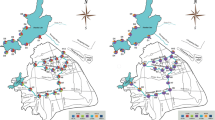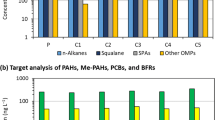Abstract
456 water samples collected from 152 water sources in 2006 were analyzed for 21 volatile organic compounds (VOCs). Concentrations of 21 VOCs ranged from below method detection limits of the laboratory to 7.65 μg/L (toluene), but seldom exceeded the concentration limits set in the National Drinking Water Quality Standards (GB5749-2006) or the National Environmental Quality Standards for Surface Water (GB3838-2002) of China. Of the 21 individual VOCs analyzed, 11 VOCs were detected in at least one sample at or above 1.0 μg/L; 6.6% of the water samples had a detection of at least one VOC at or above 1.0 μg/L, and 2.6% had a detection of at least two VOCs at or above 1.0 μg/L. Based on the statistical data of detection frequencies above the method detection limits, 75% of the samples detected at least one VOC, and 65% of the samples detected at least two VOCs. Chloroform, toluene, and 1,2-dichloroethene were the three most frequently detected VOCs, with detection frequencies of 76.97%, 68.42%, and 44.08%, respectively. Volatile halogenated hydrocarbons and gasoline components were the two most frequently detected VOC groups.
Similar content being viewed by others
References
Al-Mudhaf, H. F., Alsharifi, F. A., & Abu-shady, A. I. (2009). A survey of organic contaminants in household and bottled drinking water. Science of the Total Environment, 407, 1658–1668.
Baudoin, C., Charveron, M., Tarroux, R., & Gall, Y. (2002). Environmental pollutants and skin cancer. Cell Biology and Toxicology, 18(5), 341–348.
Belpomme, D., Irigaray, P., Hardell, L., Clapp, R., Montagnier, L., Epstein, S., et al. (2007). The multitude and diversity of environmental carcinogens. Environmental Research, 105(3), 414–429.
Bianchi, A. P., & Varney, M. S. (1998). Volatile organic compounds in the surface waters of a British estuary. Part 1. Occurrence, distribution and variation. Water Research, 32(2), 352–370.
Bravo-Linares, C. M., Mudge, S. M., & Loyola-Sepulveda, R. H. (2007). Occurrence of volatile organic compounds in Liverpool bay Irish sea. Marine Pollution Bulletin, 54(11), 1742–1753.
Claxton, L. D., & Woodall, G. M. (2007). A review of the mutagenicity and rodent carcinogenicity of ambient air. Mutation Research, 636(1–3), 36–94.
Ehrenfeld, J. R. (1986). Controlling volatile emissions at hazardous waste sites. Pollution Technology Review, 342–380. ISBN-10: 0-8155-1063-2.
Fan, C., Wang, G.-S., Chen, Y.-C., & Ko, C.-H. (2009). Risk assessment of exposure to volatile organic compounds in groundwater in Taiwan. Science of The Total Environment, 407(7), 2165–2174.
Golfinopoulos, S. K., Kostopoulou, M. N., & Lekkas, T. D. (1998). Volatile halogenated organics in the water supply system in Athens, Greece. Water Research, 32(6), 1811–1818.
Golfinopoulos, S. K., Lekkas, T. D., & Nikolaou, A. D. (2001). Comparison of methods for determination of volatile organic compounds in drinking water. Chemosphere, 45(3), 275–284.
Grady, S. J., & Casey, G. D. (2001). Water resources investigations report 00-4228. Denver: U.S. Geological Survey.
Howard, P. H. (1991a). Handbook of environmental fate and exposure data for organic chemicals (Vol. I). USA: Lewis.
Howard, P. H. (1991b). Handbook of environmental fate and exposure data for organic chemicals (Vol. II). USA: Lewis.
Kavcar, P., Odabasi, M., Kitis, M., Inal, F., & Sofuoglu, S. C. (2006). Occurrence, oral exposure and risk assessment of volatile organic compounds in drinking water for Izmir. Water Research, 40(17), 3219–3230.
Kostopoulou, M. N., Golfinopoulos, S. K., Nikolaou, A. D., Xilourgidis, N. K., & Lekkas, T. D. (2000). Volatile organic compounds in the surface waters of Northern Greece. Chemosphere, 40, 527–532.
Kuo, H. W., Chiang, T. F., Lo, I. I., Lai, J. S., Chan, C. C., & Wang, J. D. (1997). VOC concentration in Taiwan’s household drinking water. The Science of the Total Environment, 208(1–2), 41–47.
Lopes, T. J., & Bender, D. A. (1998). Nonpoint sources of volatile organic compounds in urban areas—Relative importance of land surfaces and air. Environmental Pollution, 101, 2221–2230.
Moran, M., Grady, S., & Zogorski, J. (2001). Occurrence and distribution of volatile organic compounds in drinking water supplied by community water systems in the Northeast and Mid-Atlantic regions of the United States, 1993–1998. U.S. Geological Survey Fact Sheet 089-01.
Morrow, W. S. (1999). Volatile organic compounds in ground water of the lower Illinois river basin. Water Resources Report (pp. 99–4229). U.S. Geological survey. Retrieved Jan. 14, 2010 from http://il.water.usgs.gov/proj/lirb/pubs/pdfs/voc.pdf.
Ndon, U. J., Randall, A. A., & Khouri, T. Z. (2000). Reductive dechlorination of tetrachloroethylene by soil sulfate-reducing microbes under various electron donor conditions. Environmental Monitoring and Assessment, 60, 329–336.
Nikolaou, A. D., Golfinopoulos, S. K., Kostopoulou, M. N., Kolokythas, G. A., & Lekkas, T. D. (2002). Determination of volatile organic compounds in surface waters and treated wastewater in Greece. Water Research, 36(11), 2883–2890.
Orchard, B. J., Doucette, W. J., Chard, J. K., & Bugbee, B. (2000). A novel laboratory system for determining fate of volatile organic compounds in planted systems. Environmental Toxicology and Chemistry, 19, 888–894.
Sacks, R., & Akard, M. (1994). High-speed GC analysis of VOCs: Tunable selectivity and column selection. Part 2. Environmental Science and Technology, 28(9), 428A–433A.
Squillace, P. J., Scott, J. C., Moran, M. J., Nolan, B. T., & Kolpin, D. W. (2002). VOCs, pesticides, nitrate, and their mixtures in groundwater used for drinking water in the United States. Environmental Science and Technology, 36, 1923–1930.
Squillace, P. J., Moran, M. J., & Price, C. V. (2004). VOCs in shallow groundwater in new residential/commercial areas of the United States. Environmental Science and Technology, 38(20), 5327–5338.
Tang, Z. N., Xu, Z. L., Wen, X. Y., & Yang, H. (2008). Assessment and countermeasures of pollution situation for volatile organic compounds (VOC) from water of Xiangjiang River in Zhuzhou. Journal of Hunan University of Technology, 22(2), 63–67.
USEPA Method 524.2 (1995). Measurement of purgeable organic compounds in water by capillary column gas chromatography/mass spectrometry. Retrieved Jan. 14, 2010 from http://www.epa.gov/sam/pdfs/EPA-524.2.pdf.
Wolska, L., Konieczka, P., Jastrzebska, A., & Namiesnik, J. (2003). Analytical procedure for the determination of chlorobenzenes in sediments. Journal of Chromatographic Science, 41(2), 53–56.
Xiao, X. M., Wang, X. M., Liu, Z. F., & Fu, J. M. (2001). Study on volatile organic compounds in some bottled drinking water in China. Research of Environment Science, 14(1), 61–64.
Yang, L. L., Hu, E. Y., Mu, Y. F., & Ji, Y. (2006). Study on the variety and levels of volatile organic compounds (VOCs) in drinking water of Nanjing. Chemical Reagent (Huaxue Shiji), 28(11), 688–690.
Author information
Authors and Affiliations
Corresponding author
Rights and permissions
About this article
Cite this article
Liu, L., Zhou, H. Investigation and assessment of volatile organic compounds in water sources in China. Environ Monit Assess 173, 825–836 (2011). https://doi.org/10.1007/s10661-010-1426-3
Received:
Accepted:
Published:
Issue Date:
DOI: https://doi.org/10.1007/s10661-010-1426-3




